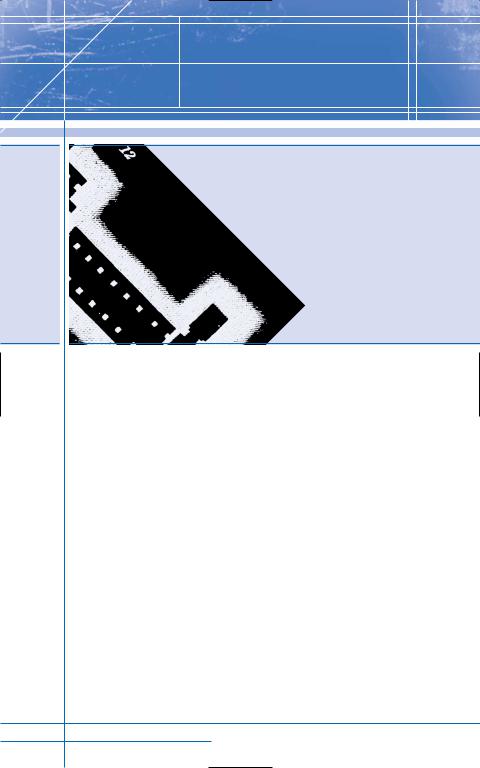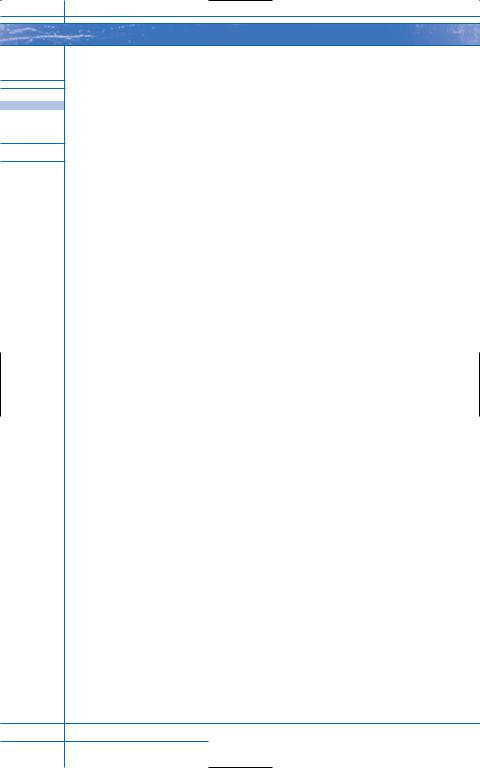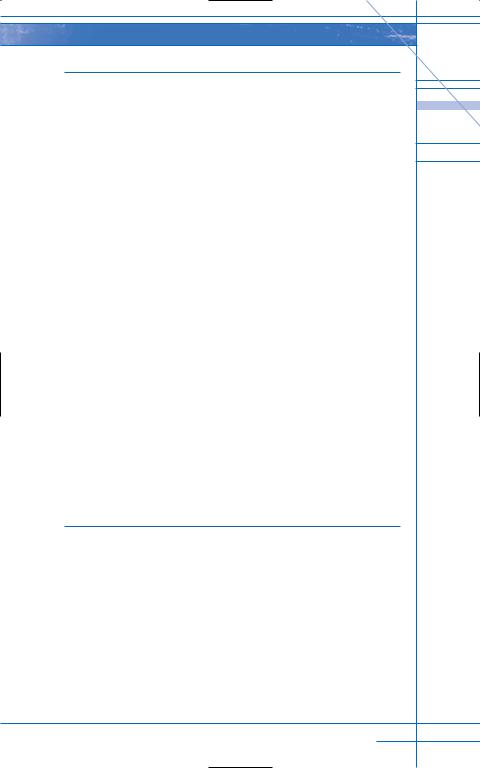
- •Table of Contents
- •Introduction
- •The 5 Dramatic Throughlines
- •The 6 Conflicts
- •The 21 Genres
- •The Replay
- •Fate
- •The Parallel
- •The Episodic
- •The Journey
- •Interactive
- •Metafiction
- •The Slice of Life
- •Introducing the 55 Dramatic Situations
- •Situations 1 & 2
- •Situations 3 & 4
- •Situations 5 & 6
- •Situations 7 & 8
- •Situations 15 & 16
- •Situations 17 & 18
- •Situations 43 & 44
- •Situations 45 & 46
- •Situations 47 & 48
- •Situations 49 & 50
- •Situations 51 & 52
- •Research

Fate |
FROM MILDRED PIERCE |
At a beach house at night a gun fires six times in rhythmic tempo, killing owner Monte Beragon.
The murderer is unseen.
The bullets shatter a mirror behind the victim. The victim lurches forward, slumps over, and falls to the floor in front of a flickering fire; the gun is tossed in front of the body. The dying man’s only word:
“Mildred!”
After being questioned by police, Mildred recalls the unfolding events that led to the breakup of her first marriage and to the murder in a flashback.
In the Fate structure, the Climax takes place at the beginning of the story as well as at the end. What follows from this Opening Climax is a flashback, or two, of events that led to the Climax just seen. Following the Final Climax is the Resolution, which is what the reader has been waiting for. “What happened to the character after the Climax?” is the real question that keeps the reader reading. In this structure the hero cannot escape the climatic event—it is her Fate. There is nothing she can do differently and the events
must be related as they exactly happened. The Resolution may have twists and turns or surprises for the audience, but the flashback must stick to the facts and events as they happened. Otherwise you are writing a Replay story where several characters tell their version of what happened. You can combine Replay and Fate in this way, but Replay will become the dominating structure. A twist in the Resolution may be that that the worst of the danger is averted. Perhaps the victim was wearing a bulletproof vest and survived the shooting in the Climax.
The Character Is Defeated Throughline works very well here. Think of the film noir type of stories—The Postman Always Rings Twice and Double Indemnity. A character is defeated in the opening scene and we see his panic and despair as he starts the flashback by relating how he got into this mess.
There can be a tragic/positive storyline such as “Look at what
44 Story Structure Architect

happened to my friend who just died.” Then there is a flashback to the Main Character’s life with this friend where we learn in the Resolution that the Main Character is okay with his friend’s death and grateful for their time together.
As you can see, the Fate type of story can easily have first-person narration as the hero tells us what has already happened to him. For example, Forrest Gump opens with a feather wafting through blue sky to land at Forrest’s feet. He’s sitting at a bus stop and proceeds to tell anyone who happens by about his remarkable life. This story combines Fate structure with mini stories strung together like a series of episodes.
Fate Structure
There is still a sense of a clear three-act beginning, middle, and end to Fate, even though it opens with the Climax:
Act I |
Act II |
Act III |
This structure is both plot and character driven. The plot pushes the character into a harsh situation where the character in turn has to make choices. Both work together to propel the story forward. The Main Character reacts to events within the story but she also acts to create events of her own.
Fate Elements
ACT I TRADITIONAL ELEMENTS
•Setup: This comes from the Final Climax being presented, setting up what will happen in the flashback.
•Mood or Tone
•Hook, Catalyst, or Inciting Incident: This comes from wondering how the Main Character got to the point of the Climax or from wondering what will happen to the him after the Climax.
•Serious Problem and/or Goal
•Villain: This may be the hero, or antihero. This is common in this structure, as the hero has often done something wrong in the opening Climax.
•Main Characters: All of them should be introduced here.
•Turning Point
Fate 45

ACT I NEW ELEMENTS
The story opens with the Final Climax. The Main Character may be defeated, killed, or arrested, or he may barely get away from danger by the skin of his teeth. He may be nostalgic and just have the desire within him to tell his story even if it isn’t tragic. There needs to be some sort of psychological component here to make it interesting.
After all, Fate wouldn’t work very well if it were an action film where Sylvester Stallone kills some meaningless bad guy in the opening climatic scene. Who would sit and watch the entire movie after the fact? Now if the man he kills was his father or he was sitting on death row for murder because of it, then it would be interesting.
Once the Final Climax is shown, the story begins with introducing all Main Characters.
Besides plot and character to drive the story forward, there is always the sense of Fate driving the story and Main Character to a specific ending. We know the Main Character should make different choices along the way, but we also know there is no way she can.
The Final Climax may set up the hero as an antihero if we know he has done something terribly wrong but we want to root for him anyway. Perhaps he robbed a bank or stole from his family.
Sometimes the tragedy of the situation is magnified if we see the hero or other characters within the main story getting a chance, however small, to make a different choice or accept help from someone who is available and willing.
ACT I QUESTIONS
•Will this be an antihero story? If so, how bad will the hero be?
•Will you have first-person narration? Or tell the story in third person after the beginning Climax?
•How many characters are involved?
•What is your purpose in telling this story? Is there a theme you are examining if writing about unscrupulous characters? (Unscrupulous characters, if used, usually stand for society as a whole or for what society does to an individual to drive him to such behavior. Of course these characters could have dealt with things in a more positive way, so don’t forget to state why they didn’t.)
46 Story Structure Architect

ACT II TRADITIONAL ELEMENTS
• Problem Intensifies
•Temporary Triumph: This is optional but used to keep the character going down the road she is going. If she is destructive, she thinks she’ll get away with it, so why not keep forging ahead?
•Reversal: This is used if there was a Temporary Triumph.
ACT II NEW ELEMENTS
The Main Character moves along, getting herself in deeper and deeper. If she’s destructive, she may trust the wrong people and make bad decisions. If she isn’t destructive, she may find herself more emotional about the events in the story she is telling, or she may see the story in a new light as she recounts it.
Things happen to make us like the Main Character a little. No character is ever totally evil; there should always be at least one endearing quality about her.
Act II is all about getting to the end and showing the reader how it all came to be. Don’t be afraid to make it interesting.
ACT II QUESTIONS
•Will you have a Temporary Triumph? Why? Make the Reversal believable?
•Will you explore the psyche of the Main Character? Show us more about her and how she got into this mess?
•How do other characters feel about the Main Character?
•What motivates the Main Character to keep going? Is he greedy? Does she want to pay respects to someone who has passed on through telling their story?
ACT III TRADITIONAL ELEMENTS
•Final Obstacle: This is the moment the reader has been waiting for. What is the Final Obstacle that leads to the Opening Climax?
•Climax
•Resolution
ACT III NEW ELEMENTS
The Main Character is thrust into a Final Obstacle. This is the big scene that leads to the Opening Climax. Everything is explained and all loose ends are tied up here instead of being tied up in the Resolution. We know who, what, when,
Fate 47

where, why, and how. Now we wait to see the Climax again so we can see what the Resolution will bring.
The driving force behind the Main Character is revealed. She spills the beans and may try to defend herself against the “law.” She may even try to charm her way out of punishment.
The Resolution is our first moment in real time since the film began. The narration is over and the Climax is completed. What will happen to the Main Character now if she is still alive? Many noir films show the hero being driven off in a police car.
ACT III QUESTIONS
•How will you show the Final Obstacle? How many characters will be involved?
•Do unscrupulous characters get away with it in the end?
•Do sympathetic characters find the closure they may be looking for? (Think Forrest Gump.)
•If destructive, is the Main Character sorry for her actions? Or still trying to get away with it? (Think film noir.)
•How did the story affect the other characters? Does anyone feel vindicated?
•What is the theme or message here if you have one?
EXAMPLES
Double Indemnity, JAMES M. CAIN
The story opens as Walter arrives at his office in the middle of the night to deliver his confession for killing a man “for money and for a woman” into a dictating machine.
Mildred Pierce, JAMES M. CAIN
A mother feels guilty for raising a destructive daughter and tries to protect her at all costs. The opening scene shows a murder where the mother is implicated. The present-day voiceover tells us she is being held by the police.
Forrest Gump, ROBERT ZEMECKIS
Forrest sits at a bus stop, talking to strangers who pass by about the events of his life and his love, Jenny. He starts at the beginning and when he reaches the present moment of him sitting on the bench, the story proceeds in real time towards his ultimate goal.
48 Story Structure Architect
